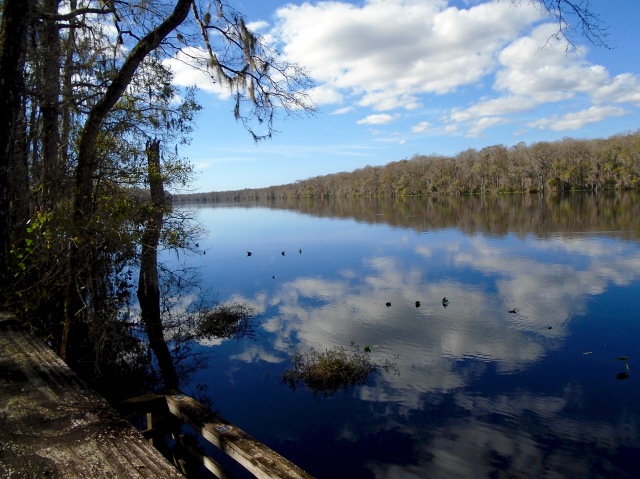
Lower Suwannee River
The Suwannee River originates in the Okefenokee National Wildlife Refuge in southeastern Georgia and flows 265 miles southwesterly through upper Florida, into the Gulf of Mexico.
As I child I learned Stephen Foster’s American folk song, ‘Old Folks At Home’ and found myself humming it as I explored the Lower Suwannee River Wildlife Refuge. It is the official state song of Florida and has an interesting history, having been written prior to the abolition of slavery from the viewpoint of a slave, and subsequent revisions reflect less offensive lyrics.

Swamp palmettos
While the Park Headquarters were closed due to the recent government shutdown, the park gates were open dawn to dusk to visitors, of which I saw few. I pretty much had the place to myself, which was a strange feeling. Fifty-three-thousand acres with very few humans present is not a common occurrance for me. I had never seen a swamp of this size before– literally a hardwood forest flooded year round, filled with tupelo, cypress, sweetgum and sycamore, among others.
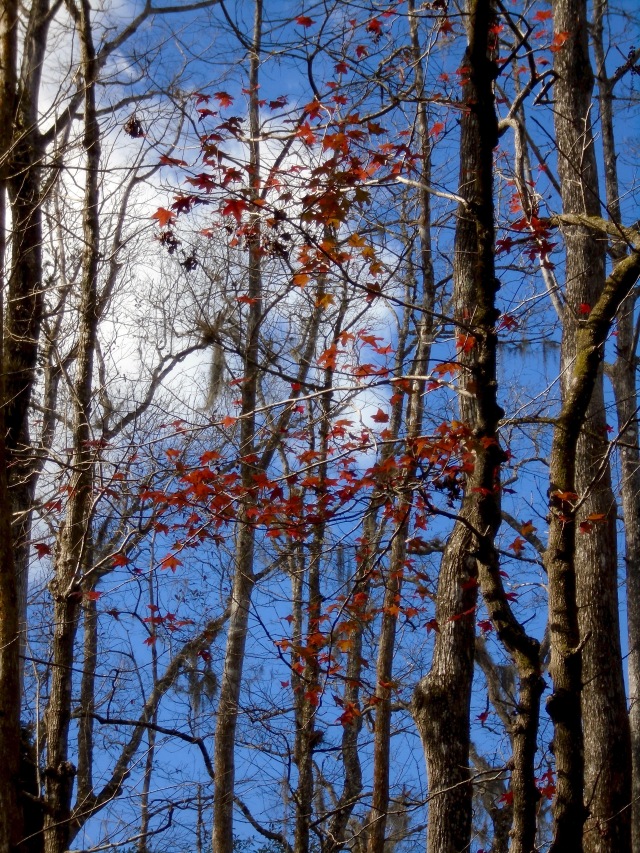
Sweetgum – autumn color
From a park info board:
“The river and its floodplain provide habitat for 232 species of birds, 72 species of reptiles, 42 species of mammals, and 39 species of amphibians. The river supports a substantial population of manatee during the warmer months and is home to the last viable breeding population of Gulf sturgeon. The estuary at its mouth supports thousands of overwintering waterfowl, migrating birds and serves as an important feeding area for nesting wading birds.”
A bit unnerved by the warning signs for cottonmouth snakes and alligators, I made my way along the loop trail to get to the open river. Part of the trail was submerged from the record amounts of autumn rainfall further up river and rather than turn back, I slogged through the ankle deep puddle, figuring I’d wash my shoes later. It turned out muddier and deeper than I expected! Ah, well, I squished onward.

Blue mirror
The sky was mirrored in many places, making it a puzzle to figure where the trunks ended and the water reflection began. I was thrilled with the sounds of large flocks of robins, warblers and the distant calls of pileated woodpeckers. I felt a bit untrained in this type of habitat and alert for any danger – alligators at rest look like submerged logs, of which there were many broken trees in the tannin-rich water, so even if there were ‘gators, I didn’t recognize any. Luckily, most of the trail was an elevated boardwalk.
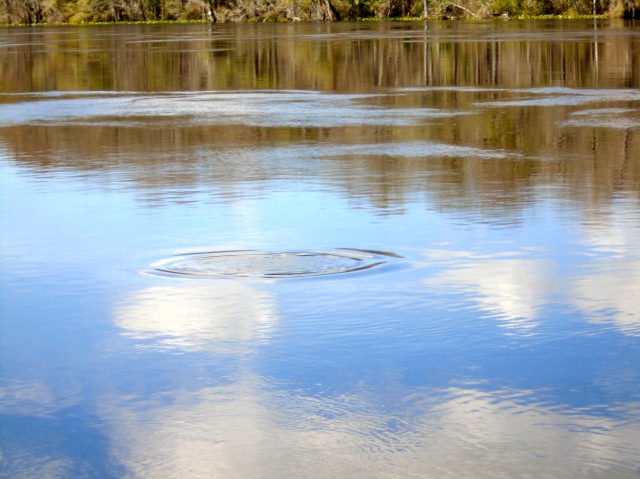
Fish rising
The river was swiftly flowing once I got out to it, with large fish jumping and splashing in the cloud-dotted waters. It was so peaceful, despite the fact that it felt odd being so utterly alone.
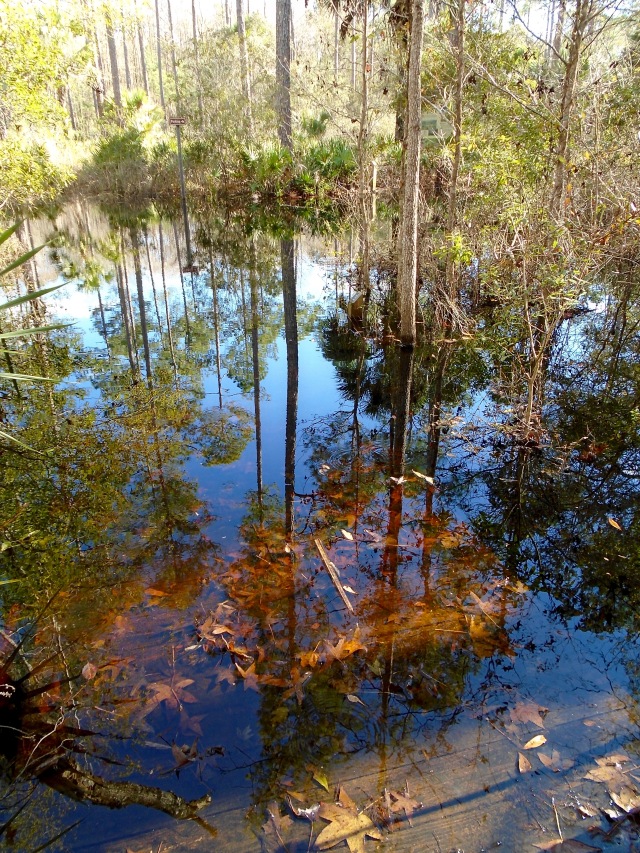
Flooded boardwalk
I set out along the return loop and encountered flooding at the end of the boardwalk that looked too deep to navigate, so I had to return the way I came, back through that mucky puddle – ugh!
En route, I saw a floating, flat log that had been colonized by ferns, moss and a round-leaved plant, like a miniature garden. Another log sported a tall flowering ragwort. (As I’m not familiar with the flora here, my IDs are fuzzy.)
There is a nature drive that wends its way throughout the refuge, basically a system of fire roads to access the bulk of the swamp, offering a close up view from the comfort of one’s car with trails forking off for hiking. Culverts are periodically placed to ensure that water could flow freely throughout and the rushing of water around these attracted wading birds, mostly herons and egrets.
I spooked a Great Blue Heron that had caught a black snake in the road and watched it slowly and methodically dip it in water and beat it against a felled tree to stun it, until it manuevered it into position to go head-first down the gullet. I wondered if, and how, birds ate poisonous snakes without being bit or harmed by ingesting venom?
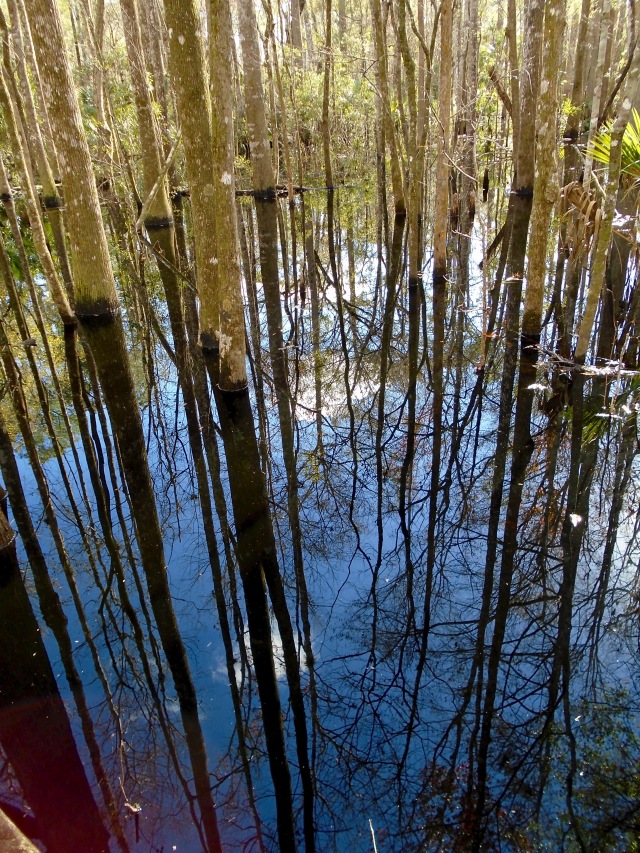
Swamp mirror
What thrilled me most was seeing miles of habitat set aside exclusively for wildlife, many of which were familiar avian migrants that populate our northern forests in the summer breeding season. As more acreage every day is lost to human development, I was grateful that at least here was a place where they could live in good health and peace.








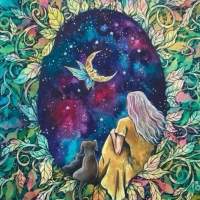

Love the pics with the reflections
Thank you, Harold.